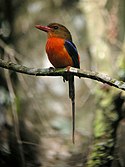Tanysiptera
| Tanysiptera[1] | |||
| Vigors, 1825[2] | |||
 Przedstawiciel rodzaju – sterowik brązowy (T. danae) | |||
| Systematyka | |||
| Domena | |||
|---|---|---|---|
| Królestwo | |||
| Typ | |||
| Podtyp | |||
| Gromada | |||
| Podgromada | |||
| Infragromada | |||
| Rząd | |||
| Nadrodzina | |||
| Rodzina | |||
| Podrodzina | |||
| Rodzaj | Tanysiptera | ||
| Typ nomenklatoryczny | |||
Alcedo dea Linnaeus, 1766[a] (= Tanysiptera nais G.R. Gray, 1861) | |||
| Synonimy | |||
| Gatunki | |||
| |||
Tanysiptera – rodzaj ptaka z podrodziny łowców (Halcyoninae) w rodzinie zimorodkowatych (Alcedinidae).
Zasięg występowania
Rodzaj obejmuje gatunki występujące w Australazji[5].
Morfologia
Długość ciała 28–48 cm (włącznie z silnie wydłużonymi środkowymi sterówkami); masa ciała 37–78 g[5].
Systematyka
Etymologia
- Tanysiptera: gr. τανυσιπτερος tanusipteros „długopióry”, od τανυ- tanu- „długi”, od τεινω teinō „rozciągać”; -πτερος -pteros „-pióry”, od πτερον pteron „pióro”[6].
- Uralcyon: gr. ουρα oura „ogon”; rodzaj Halcyon Swainson, 1821 (łowiec)[7]. Gatunek typowy: Tanysiptera sylvia Gould, 1850.
- Edquista: Alfred George Edquist (1873–1966), australijski pedagog, kolekcjoner[8]. Gatunek typowy: Tanysiptera carolinae Schlegel, 1871.
Podział systematyczny
Do rodzaju należą następujące gatunki[9]:
- Tanysiptera sylvia Gould, 1850 – sterowik białogrzbiety
- Tanysiptera nympha G.R. Gray, 1840 – sterowik czerwonobrzuchy
- Tanysiptera danae Sharpe, 1880 – sterowik brązowy
- Tanysiptera hydrocharis G.R. Gray, 1858 – sterowik białobrzuchy
- Tanysiptera ellioti Sharpe, 1870 – sterowik wstęgosterny
- Tanysiptera riedelii J. Verreaux, 1866 – sterowik łuskowany
- Tanysiptera carolinae Schlegel, 1871 – sterowik niebieskobrzuchy
- Tanysiptera galatea G.R. Gray, 1859 – sterowik duży
Uwagi
- ↑ Nie Alcedo dea Linnaeus, 1758.
Przypisy
- ↑ Tanysiptera, [w:] Integrated Taxonomic Information System [online] (ang.).
- ↑ N.A. Vigors. Observations on the Natural Affinities that connect the Orders and Families of Birds. „Transactions of the Linnean Society of London”. 14, s. 433, 1825. (ang.).
- ↑ F. Heine. Ueber einige neue oder weniger bekannte Vögel des „Museum Heineanum“. „Journal für Ornithologie”. 7, s. 406, 1859. (niem.).
- ↑ G.M. Mathews: The birds of Australia. Cz. 7. H.F. & G. Witherby: London, 1918–1919, s. 198. (ang.).
- ↑ a b D.W. Winkler, S.M. Billerman & I.J. Lovette: Kingfishers (Alcedinidae), version 1.0. W: S.M. Billerman, B.K. Keeney, P.G. Rodewald & T.S. Schulenberg (red.): Birds of the World. Ithaca, NY: Cornell Lab of Ornithology, 2020. DOI: 10.2173/bow.alcedi1.01. [dostęp 2020-10-14]. (ang.).

- ↑ Tanysiptera, [w:] The Key to Scientific Names, J.A. Jobling (red.), [w:] Birds of the World, S.M. Billerman et al. (red.), Cornell Lab of Ornithology, Ithaca [dostęp 2022-01-23] (ang.).
- ↑ Uralcyon, [w:] The Key to Scientific Names, J.A. Jobling (red.), [w:] Birds of the World, S.M. Billerman et al. (red.), Cornell Lab of Ornithology, Ithaca [dostęp 2022-01-23] (ang.).
- ↑ Edquista, [w:] The Key to Scientific Names, J.A. Jobling (red.), [w:] Birds of the World, S.M. Billerman et al. (red.), Cornell Lab of Ornithology, Ithaca [dostęp 2022-01-23] (ang.).
- ↑ Systematyka i nazwy polskie za: P. Mielczarek & M. Kuziemko: Podrodzina: Halcyoninae Vigors, 1825 - łowce (wersja: 2020-01-11). [w:] Kompletna lista ptaków świata [on-line]. Instytut Nauk o Środowisku Uniwersytetu Jagiellońskiego. [dostęp 2020-10-14].
Media użyte na tej stronie
Autor: Jakob Voß, influenced by original art designed at PLoS, modified by Wikipedia users Nina and Beao, Licencja: CC0
Closed Access logo, derived from PLoS Open Access logo. Alternative version.
Autor: (of code) -xfi-, Licencja: CC BY-SA 3.0
The Wikispecies logo created by Zephram Stark based on a concept design by Jeremykemp.
Autor: markaharper1, Licencja: CC BY-SA 2.0
Brown-headed Paradise-kingfisher (Tanysiptera danae)


